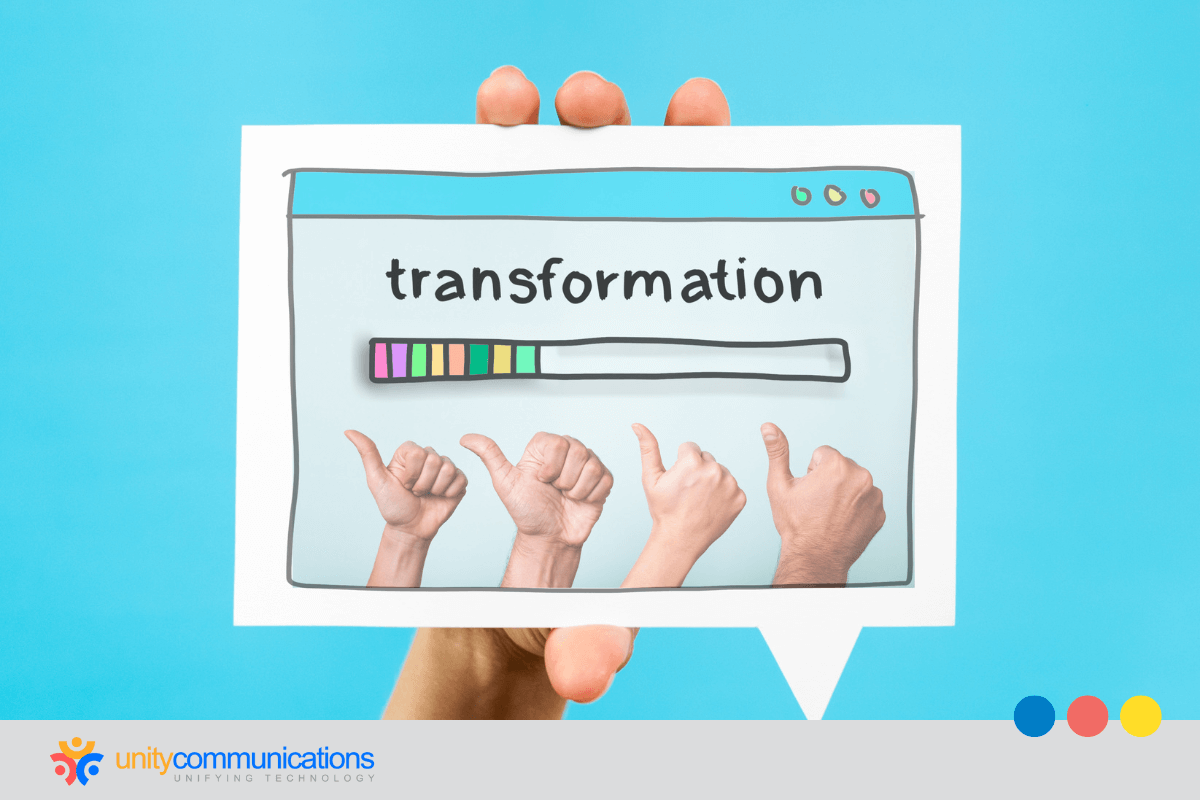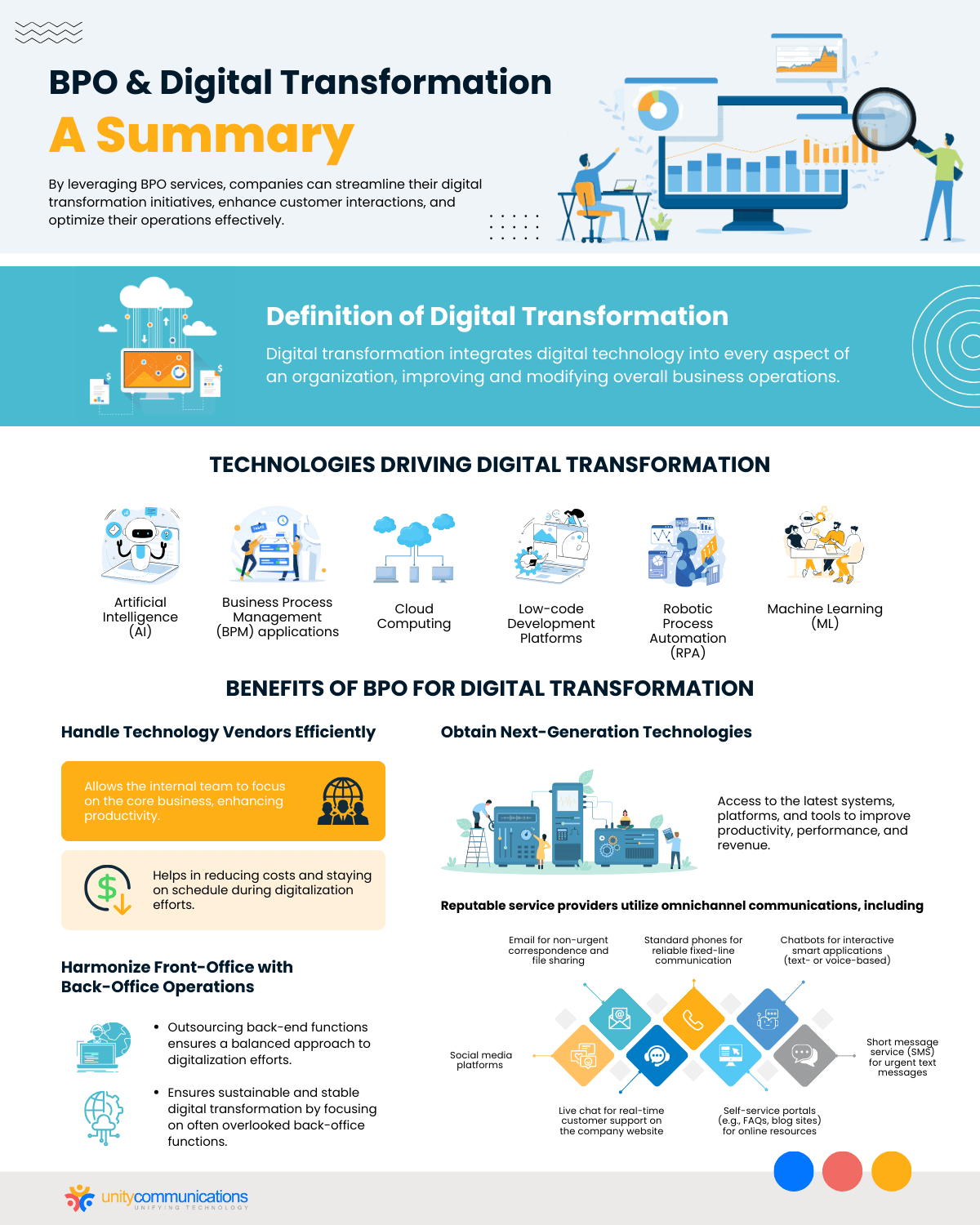Table of Contents
Recent developments, including the pandemic and the global economic slowdown, have spurred the need for digital transformation and caused a significant shift in business operations worldwide.
What is the role of business process outsourcing (BPO) in the digital transformation strategies of organizations? How can BPO contribute to attaining its technology goals?
This article discusses BPO and digital transformation, explaining how these factors are connected, their benefits, and best practices. It also explores a case study of the successful use of BPO for digital transformation.
How BPO and Digital Transformation Are Connected

First of all, what is BPO? This strategy involves delegating business processes to a third-party provider, including back-office and front-office operations. These providers ensure high-quality work outputs by following a comprehensive service-level agreement (SLA) and measurable metrics known as key performance indicators (KPIs).
Digital transformation, on the other hand, combines digital technology into every part of an organization. This process significantly improves and modifies overall business operations by streamlining the current workflow and providing higher value to customers and clients.
Also known as digitalization, the procedure harnesses the latest and most relevant technologies such as the following:
- Artificial intelligence (AI) imitates human mental ability in computer systems or other digital devices to perform tasks requiring intelligence.
- Business process management (BPM) applications enable businesses to monitor, automate, and enhance regular business operations.
- Cloud computing is the distribution of various services over the Internet, consisting of databases, computer systems, networking, and applications.
- Low-code development platforms permit software developers to enhance or customize programs with minimal hand-coding and modifications.
- Robotic process automation (RPA) is a type of business process automation that lets a “bot” perform specific tasks to improve productivity and customer experience.
- Machine learning (ML) is an AI branch that enables computers to acquire knowledge, analyze data patterns, and develop their capabilities using algorithms and models.
So how are BPO and digital transformation connected? Back-office and front-office operations are highly interlinked. Technological innovation, such as digitalization, harnesses information technology (IT) resources, removes silos, and integrates and automates processes to achieve organizational goals.
Outsourcing helps implement a digital transformation strategy. Organizations can seek a service provider to delegate a part of their processes. This can lead to easier vendor management, better competitiveness, and access to advanced contact centers and other outsourcing-related technologies.
Benefits of BPO for Digital Transformation

Companies can tap into the outsourcing industry to enable their digitalization initiatives. Consider the advantages of partnering with a BPO provider.
Here’s how AI in the BPO industry works.
Handle Technology Vendors to Speed up Digitalization Drive
Obtaining up-to-date technologies throughout the digital transformation period can be time-consuming. Software vendors offer numerous technology solutions that can be complex for in-house staff and costly for the organization. Managing them without sufficient knowledge and expertise will likely impede the company’s digitalization efforts.
Work with a service provider to reduce the pressure of handling several supplier interactions and allow the internal team to focus on the core business. Delegate vendor management to reduce in-house workload and retain employee productivity. Having a BPO partner during digitalization helps the company reduce costs by staying focused and on schedule.
Harmonize the Front-Office with Back-Office for Seamless Operations
If appropriately implemented, advanced technology can improve customer service and office processing operations and drive business growth. But some companies are preoccupied with front-office services such as sales, marketing, and customer relationships. Back-office functions are typically taken for granted and overlooked.
Outsource back-end functions to a service provider to ensure the company’s digitalization efforts are well-balanced and on the right track. Third-party vendors can maximize data entry, finance, human resources (HR), and other supplementary activities for sustainable and stable digital transformation.
Obtain Next-Generation Technologies to Simplify Communications
Acquiring BPO services means accessing the latest systems, platforms, and tools to improve productivity, performance, and revenue. In particular, established and reputable service providers utilize omnichannel communications to enhance internal and external interaction.
BPO and digital transformation work best when all communication channels are optimized, unified, and accessible anytime, anywhere. Below are some omnichannel modes:
- Social media is a social interaction platform (e.g., Facebook, Instagram, and TikTok).
- Email is for non-urgent correspondence and sending of large files.
- Live chat lets anyone contact a live support agent on the company website.
- Standard phones are dependable and convenient fixed-line phones.
- Self-service portals are useful online resources (e.g., FAQs and blog sites).
- Chatbots allow individuals to interact with a smart application (text- or voice-based).
- Short message service (SMS) is for sending brief text messages for urgent matters.
Challenges of BPO for Digital Transformation

The following are three common issues when utilizing BPO for digital transformation (with recommended actions).
Exposure to Data Security Violation
Outsourcing services involves exchanging critical consumer and corporate data with a third-party vendor. Financial data, login details, and passwords are a few examples. Security breaches or unauthorized network entry can occur from unprotected or unauthenticated files. Compromised data can lead to financial consequences and a negative business image.
Recommended action: Learn about the data safety and confidentiality measures the BPO provider offers. The third-party team must adhere to robust security procedures when obtaining and utilizing data. Furthermore, ask the service provider to formally consent to a non-disclosure agreement (NDA).
Communication Gaps or Barriers
Unlike performing processes internally, communications might be limited when using nearshore or offshore outsourcing or other types of subcontracting. The service provider is thousands of miles from the company’s main office. During unforeseen circumstances, proximity to the provider helps resolve pressing issues more quickly and effectively.
Recommended action: Both parties must address this issue from the beginning of the partnership for BPO and digital transformation to work effectively. Build a solid communication plan with the service provider by deploying multichannel or omnichannel capabilities to minimize communication gaps or hurdles.
Loss of Management Control
Cutting costs and enhancing efficiency and output are among the reasons the company transfers tasks to the service provider. But to acquire these outsourcing benefits, it must give up a certain degree of control. It must permit the partner to manage the processes using established policies and technical procedures. Its internal protocols will likely be ignored.
Recommended action: For BPO and digital transformation to operate together, determine the specifics of the outsourcing agreement beforehand to prepare internal management for the transition. Discuss with the service provider the in-house protocols to use and let go. Clarify expectations and requirements before entering an agreement.
Case Study for the Successful Use of BPO for Digital Transformation
AIMultiple reports the latest digital transformation case studies and success stories. One successful BPO and digital transformation case is the British shirt producer Thomas Pink, a Louis Vuitton Moet Hennessey conglomerate subsidiary.
The company outsourced the building of its online sales platform to Fits.me Virtual Fitting Room. The outsourcing process aims to gain an upper hand over its rivals in online shopping. Customers can use the online platform to assess how well their purchased clothes will fit by providing their body size.
Fits.me capitalized on the platform since formerly undisclosed consumer data, such as body dimensions and fit choices, became accessible. As such, the platform can provide clients with better-fitting apparel.
Below are the details:
- Business challenge: Inadequate insight into online revenue and consumer tastes
- Target market: Online consumers and visitors
- Line of business process: Customer success management and sales
- Solution: Subcontracting the establishment of the online system to Fits.me Virtual Fitting Room.
- Business outcome: Enhanced customer satisfaction and experience. Thomas Pink says customers using the virtual fitting room will likely buy its products compared to those who do not. The conversion rate increased by 29.6%.
The Bottom Line

The partnership between BPO and digital transformation will become more common among organizations in the foreseeable future. Both processes share the same objective: building, improving, and maintaining a company’s competitive edge by optimizing costs and output. Outsourcing and digital technology will significantly contribute to achieving this business goal.
AI, ML, BPM, cloud computing, RPA, low-code development platforms, and other advanced technologies will also increase in the BPO industry to further streamline and improve back- and front-end operations.
Let’s connect so that you can better understand how BPO and digital transformation can revolutionize your business!



